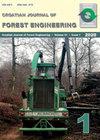改变怠速减径机驱动控制方式对燃油消耗和废气排放的影响
IF 2.1
2区 农林科学
Q1 FORESTRY
引用次数: 2
摘要
在使用低功率木材减径机(WSRM)加工树枝和锯木厂边角料的过程中,操作条件经常波动,这主要是由于木材供应频率的变化。这导致怠速时间的比例相对较高。通过在怠速期间使用创新的驱动单元控制系统,可以降低带有内燃机的WSRM的燃料消耗和相关的废气排放。本研究的目的是确定两个速度控制系统对由小型9.5 kW火花点火式发动机驱动的具有两个气缸切割机构的WSRM的燃料消耗和废气排放的影响。速度控制系统A(市售)具有比系统B高得多的转速(专利申请号P433586的创新的自适应解决方案)。松树(Pinus sylvestris L.)锯木厂边角料(平均横截面积、长度和含水量分别为25×40mm、3000mm和ca。12)用于系统测试,进料速率为ca。5片min-1。这种尺寸的材料通常由这种机器加工。通过记录转速和扭矩来监测操作条件。使用便携式排放测量系统记录有害废气化合物——一氧化碳(CO)、二氧化碳(CO2)、碳氢化合物(HC)和氮氧化物(NOx)的排放。燃料消耗值也根据数据进行了计算。观察到以下效果:创新系统B的应用使燃料消耗量比系统A降低了33%,CO、CO2和NOx排放量分别降低了30%、37%和33%,但同时HC排放量增加了290%。在怠速时间比例更高的运行条件下,解决方案B在燃油消耗和废气排放方面提供了更高的降低。本文章由计算机程序翻译,如有差异,请以英文原文为准。
Effects of Changing Drive Control Method of Idling Wood Size Reduction Machines on Fuel Consumption and Exhaust Emissions
Operating conditions often fluctuate during processing of branches and sawmill offcuts using low-power wood size reduction machines (WSRMs), mainly due to changes in wood supply frequency. This results in relatively high proportions of idling time. Fuel consumption and associated exhaust emissions of WSRMs with combustion engines can be reduced by using innovative drive unit control systems during idling. The objective of the research was to determine the effects of two speed control systems on the fuel consumption and exhaust emissions of a WSRM with a two-cylinder cutting mechanisms driven by a small 9.5 kW spark ignition engine. Speed control system A (commercially available) had a substantially higher rotational speed than system B (an innovative, adaptive solution subject to patent application No. P433586). Pine (Pinus sylvestris L.) wood sawmill offcuts (average cross-sectional area, length and water content: 25×40 mm, 3000 mm and ca. 12, respectively) were used in system tests at a feed rate of ca. 5 pieces min-1. Material of this size is typically processed by such machines. Operating conditions were monitored by recording the rotational speed and torque. Emissions of harmful exhaust compounds–carbon monoxide (CO), carbon dioxide (CO2), hydrocarbons (HC), and nitrogen oxides (NOx) – were recorded using a portable emission measurement system. Fuel consumption values were also calculated from the data. The following effects were observed: application of innovative system B resulted in 33% lower fuel consumption, as well as 30%, 37% and 33% lower CO, CO2 and NOx emissions, respectively, than system A, but at the same time 290% higher HC emissions were registered. In operating conditions with higher proportions of idling time, solution B provides even higher reductions in fuel consumption and exhaust emissions.
求助全文
通过发布文献求助,成功后即可免费获取论文全文。
去求助
来源期刊
CiteScore
5.20
自引率
12.50%
发文量
23
审稿时长
>12 weeks
期刊介绍:
Croatian Journal of Forest Engineering (CROJFE) is a refereed journal distributed internationally, publishing original research articles concerning forest engineering, both theoretical and empirical. The journal covers all aspects of forest engineering research, ranging from basic to applied subjects. In addition to research articles, preliminary research notes and subject reviews are published.
Journal Subjects and Fields:
-Harvesting systems and technologies-
Forest biomass and carbon sequestration-
Forest road network planning, management and construction-
System organization and forest operations-
IT technologies and remote sensing-
Engineering in urban forestry-
Vehicle/machine design and evaluation-
Modelling and sustainable management-
Eco-efficient technologies in forestry-
Ergonomics and work safety

 求助内容:
求助内容: 应助结果提醒方式:
应助结果提醒方式:


